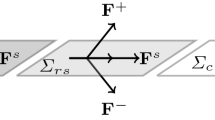Abstract
The aim of this paper is to investigate through a detailed analysis the stability and bifurcation pattern of the nonlinear phenomena in the Buck DC–DC converter. Such a study may lead to a better explanation of the dynamics behaviours of the converter. First, a nonlinear system modelling is derived for open-loop Buck converter with state variables of the input current and the output voltage. The large-signal time-domain nonlinear averaged model is used to understand the interaction on the slow scale using nonlinear analysis techniques. The model is extended for the closed-loop system while employing a proportional-integral control solution. After the initial analysis of this converter and stability region identification, we utilize the MATCONT and MATLAB packages to analyze the detailed bifurcation scenario as important parameters are varied. The analysis shows how instabilities can occur on the slow and fast scales. The simulation was performed to explore the dynamic performance.













Similar content being viewed by others
References
Abed EH, Wang HO, Tesi A (1995) Control of bifurcations and chaos. In: Levine WS (ed) The control handbook. CRC Press & IEEE Press, Boca Raton, pp 951–966
Allag A, Hadri Hamida A et al (2006) Power loss analysis in high frequency quasi resonant DC link power conversion for induction heating application. AMSE Journals 79(2):73–84 France, Mai
Deane JHB, Hamill DC (1990) Analysis, simulation and experimental study of chaos in the Buck converter. Proc IEEE Power Electron Spec Conf 491–498
Dhooge A, Govaerts W, Kuznetsov YA (2003) MATCONT: a matlab package for numerical bifurcation analysis of ODEs. ACM Trans Math Software 29:141–164
Hadri Hamida A (2011) Contribution à l’analyse et à la commande des convertisseurs DC–DC parallèles à PWM. PhD thesis, University of Biskra, Algeria
Hadri Hamida A, Allag A et al. (2004) Efficiency considerations of Quasi resonant DC link converter. In: proceedings of conference ICEMS, international conference on electrical machines and systems. Jeju Island, Korea 361–362
Hadri Hamida A, Allag A et al. (2006) Application of an adaptive nonlinear control strategy to AC-DC-PWM converter feeding induction heating. IEEE conference IECON 2006, pp. 1598–1602, Paris, France
Hadri Hamida A, Allag A et al. (2008) Adaptive nonlinear control of AC-DC-PWM converter feeding induction heating. AMSE J, vol. 63, no. 2:40–51, France
Hadri Hamida A, Zerouali S et al. (2013) Toward a nonlinear control of an AC-DC-PWM converter dedicated to induction heating. Frontiers in energy, Springer Journals, article in press
Hadri-Hamida A, Allag A et al. (2007) Adaptive nonlinear control of a passively clamped two switch quasi resonant DC link converter. Int J Appl Electromag Mech 25, no. 1–4:537–542, ISEM, IOS Press
Hadri-Hamida A, Allag A et al. (2009) A nonlinear adaptive backstepping approach applied to a three phase PWM AC-DC converter feeding induction heating. Elsevier Journals, CNSNS vol. 14, no. 4, pp. 1515–1525
Lee FC (1990) Modeling, analysis, and design of PWM converter, vol 2. Virginia Power Electronic Center Publications Series, Blacksburg
Mazumder SK, Nayfeh AH et al (2001) Theoretical and experimental investigation of the fast- and slow-scale instabilities of a DC–DC converter. IEEE Trans Power Electron 16(2):201–216
Nayfeh AH, Balachandran B (1995) Applied nonlinear dynamics. Wiley, New York
Prajoux R, Marpinard JC, Jalade J (1976) Etablissement de modeles mathematiques pour regulateurs de puissance a modulation de largeur d’impulsions (pwm). ESA Sci Tech Rev 2:25–42
Tse CK (1994) Flip bifurcation and chaos in three-state boost switching regulators. IEEE Transact Circuits Syst 41(1):16–23
Wang HO, Chen DS, Bushnellt LG (2000) Dynamic Feedback Control of Bifurcations. In: proceedings of IEEE decision and control conference,pp. 1619–1624
Wiggins S (1988) Global bifurcations and chaos. Springer, New York
Wiggins S (1990) Introduction to applied nonlinear dynamical systems and chaos. Springer, New York
Wood JR (1989) Chaos: a real phenomenon in power electronics. In: proc IEEE Appl Power Electron Conf Expo, 115–124
Zerouali S, Mimoune SM Allag A, Hadri Hamida A (2006) Zero voltage switching with optimal linear quadratic regulator for power supply feeding an induction heating. Asian Power Electron J vol. 1, no. 1, Mars
Zerouali S, Allag A, Mimoune SM, Hadri Hamida A (2007) Extended kalman filter for uninterruptible power supplies applied to non linear loads. Int J Appl Electromag Mech vol. 25, no. 1–4:565–569. ISEM Bad Gastein, IOS Press
Zerouali S, Allag A, Mimoune SM, Hadri Hamida A, Ayad MY, Miraoui A (2007) An adaptive linear quadratic regulator (LQR) applied to Buck-series resonant inverter for induction heating. AMSE J vol. 62, no. 1:94–104, France
Author information
Authors and Affiliations
Corresponding author
Rights and permissions
About this article
Cite this article
Hadri-Hamida, A., Ghoggal, A. & Zerouali, S. Bifurcation analysis of a Buck DC–DC converter applied to distributed power systems. Int J Syst Assur Eng Manag 5, 307–312 (2014). https://doi.org/10.1007/s13198-013-0161-x
Received:
Revised:
Published:
Issue Date:
DOI: https://doi.org/10.1007/s13198-013-0161-x




